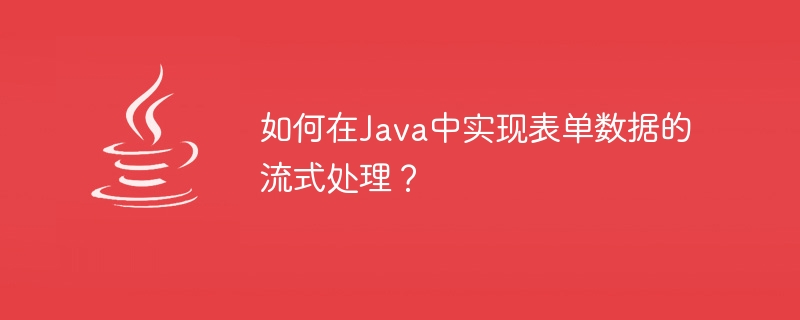

How to implement streaming processing of form data in Java?
With the rapid development of Internet technology, the processing of form data has become a common requirement in development. Moreover, as the amount of data continues to increase, traditional one-time processing methods can no longer meet the demand. In order to process form data more efficiently, Java provides a streaming processing method.
Streaming processing refers to dividing data into multiple small blocks for processing one by one to avoid loading all data at once, causing memory overflow or slow processing speed. In Java, streaming processing of form data can be achieved with the help of Apache's Commons FileUpload library.
The following is a simple sample code that demonstrates how to use Commons FileUpload to implement streaming processing of form data in Java:
import org.apache.commons.fileupload.FileItem;
import org.apache.commons.fileupload.disk.DiskFileItemFactory;
import org.apache.commons.fileupload.servlet.ServletFileUpload;
import javax.servlet.annotation.WebServlet;
import javax.servlet.http.HttpServlet;
import javax.servlet.http.HttpServletRequest;
import javax.servlet.http.HttpServletResponse;
import java.io.File;
import java.io.FileOutputStream;
import java.io.IOException;
import java.io.InputStream;
import java.util.List;
@WebServlet("/upload")
public class FileUploadServlet extends HttpServlet {
protected void doPost(HttpServletRequest request, HttpServletResponse response) throws IOException {
if (ServletFileUpload.isMultipartContent(request)) {
try {
// 创建一个上传文件的临时目录
File tempDir = new File("temp");
if (!tempDir.exists()) {
tempDir.mkdirs();
}
// 创建一个DiskFileItemFactory对象,用于设置缓冲区大小和临时目录
DiskFileItemFactory factory = new DiskFileItemFactory();
factory.setSizeThreshold(1024 * 1024); // 设置缓冲区大小(1MB)
factory.setRepository(tempDir); // 设置临时目录
// 创建一个ServletFileUpload对象
ServletFileUpload upload = new ServletFileUpload(factory);
// 解析表单数据
List<FileItem> items = upload.parseRequest(request);
// 处理表单数据
for (FileItem item : items) {
if (item.isFormField()) {
// 处理普通表单字段(非文件字段)
String fieldName = item.getFieldName(); // 表单字段名称
String value = item.getString("UTF-8"); // 表单字段值
// TODO: 对表单字段进行处理
} else {
// 处理文件字段
String fieldName = item.getFieldName(); // 表单字段名称
String fileName = item.getName(); // 文件名
InputStream inputStream = item.getInputStream(); // 文件内容输入流
// TODO: 对文件进行处理,例如保存到本地
File file = new File(fileName);
FileOutputStream out = new FileOutputStream(file);
byte[] buffer = new byte[1024];
int len;
while ((len = inputStream.read(buffer)) > 0) {
out.write(buffer, 0, len);
}
out.close();
inputStream.close();
}
}
// 返回处理结果
response.getWriter().println("文件上传成功!");
} catch (Exception e) {
e.printStackTrace();
response.getWriter().println("文件上传失败:" + e.getMessage());
}
} else {
response.getWriter().println("请上传文件!");
}
}
}
In the above code, we first determine whether the request is multi-part request (i.e. containing a file upload) and then creates a temporary directory for the uploaded files.
Next, we use DiskFileItemFactory to set the buffer size and temporary directory, and create a ServletFileUpload object. Parse the form data by calling the parseRequest method and get a list of file items.
When traversing the file item list, we use the isFormField method to determine whether the current item is a normal form field or a file field. If it is a normal form field, we can get the field name and value through the getFieldName and getString methods. If it is a file field, we can get the field name and file name through the getFieldName and getName methods, and get the file content input stream through the getInputStream method. Finally, we can perform corresponding processing on the form fields and file fields, such as saving the file locally.
Finally, we return the processing results to the client through the response object.
Through the above sample code, we can easily implement streaming processing of form data in Java, improve processing efficiency and be compatible with scenarios with large amounts of data. Of course, for more complex needs, we can also implement more functions through further learning and flexible use of the Commons FileUpload library, such as file upload progress display, customized file processing, etc.
Summary:
In this article, we introduced how to use Apache's Commons FileUpload library to implement streaming processing of form data in Java. Through streaming processing, processing efficiency can be improved and compatible with scenarios with large amounts of data. I hope this article will help you understand and apply streaming processing.
The above is the detailed content of How to implement streaming of form data in Java?. For more information, please follow other related articles on the PHP Chinese website!
